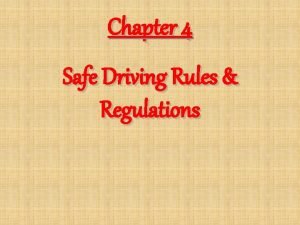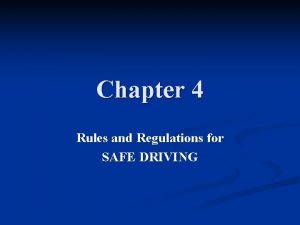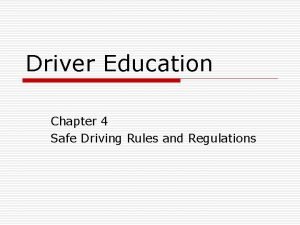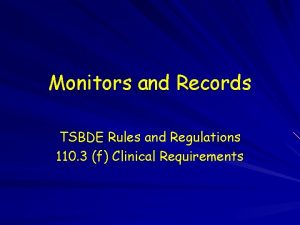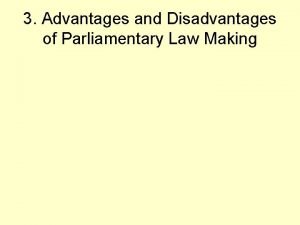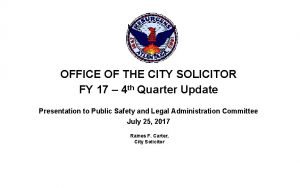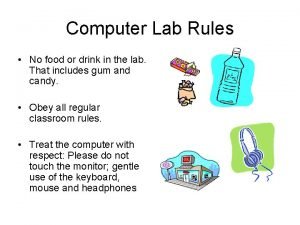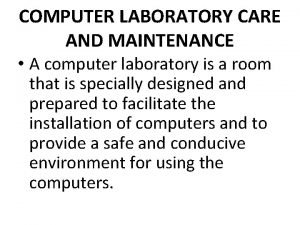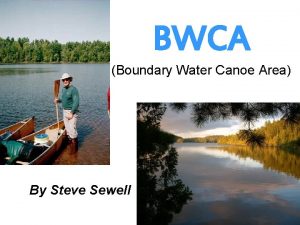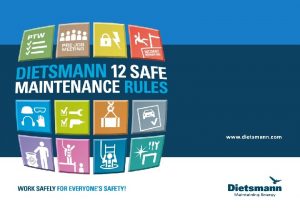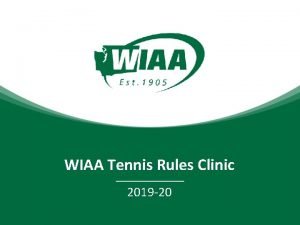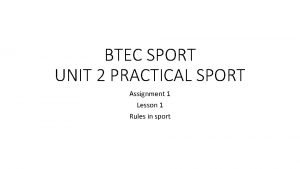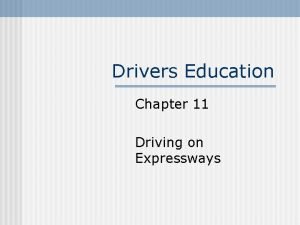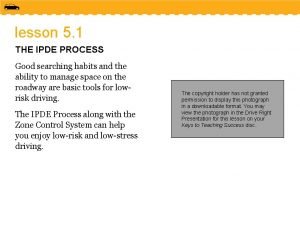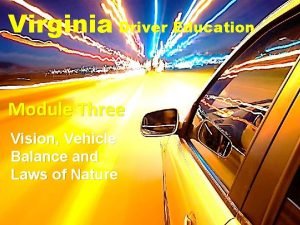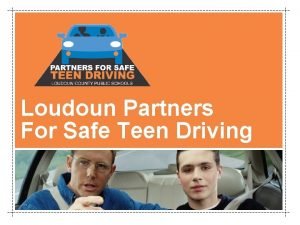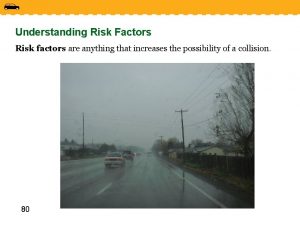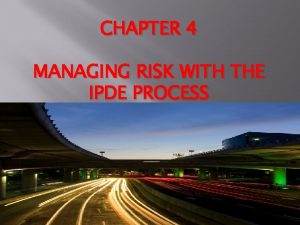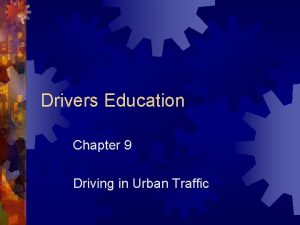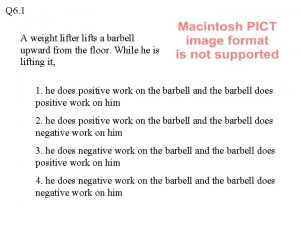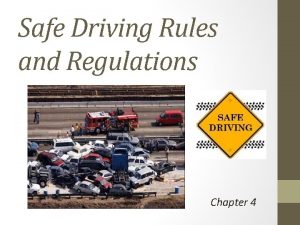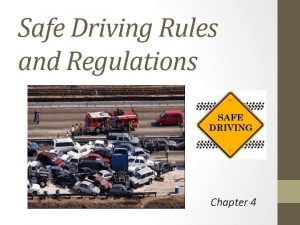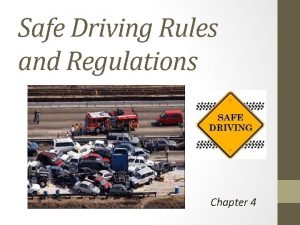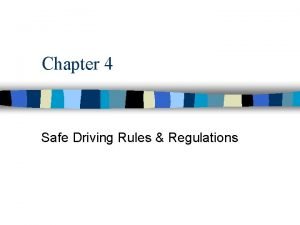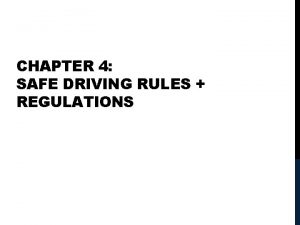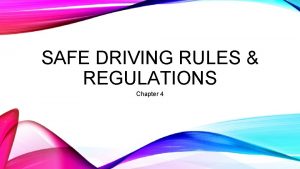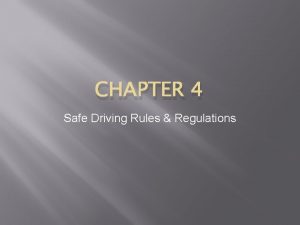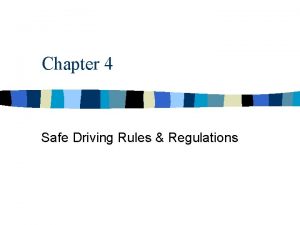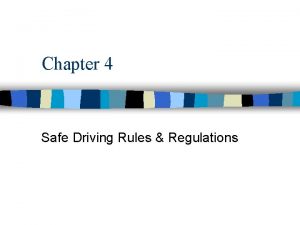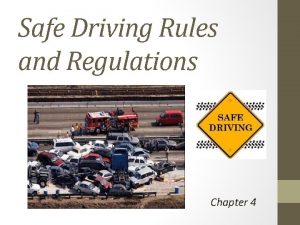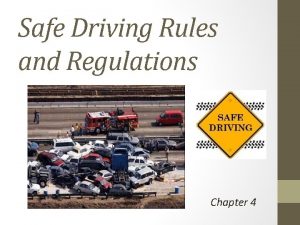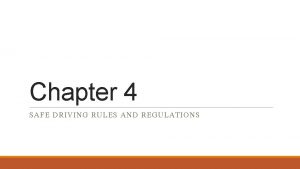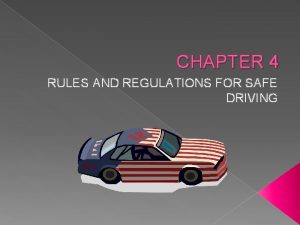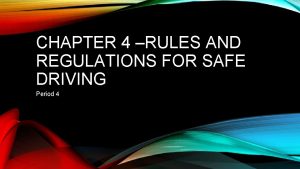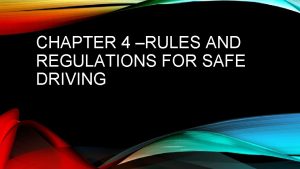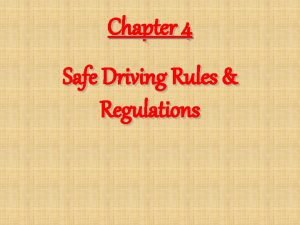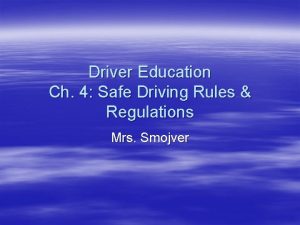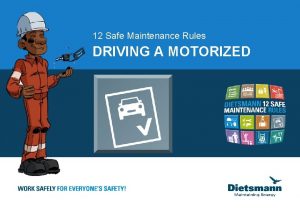Chapter Four Safe Driving Rules and Regulations Speed





























- Slides: 29

Chapter Four Safe Driving Rules and Regulations

Speed Control: A. B. C. Speeding is a common cause of fatal accidents. Keep up with the flow of traffic at any legal speed. Make glances to your speedometer to stay in touch with your speed.

New Jersey Speed Limits: A. B. C. D. E. *25 mph – school zones, business or residential districts 35 mph – certain low density business & residential districts. *50 mph–All other roadways/not posted 55 mph – certain state highways (as posted) & all interstate highways 65 mph – certain interstate highways (as posted)

Facts about Speeding o The higher the speed: n n n The less time the driver has to spot dangerous situations The greater the time and distance it takes to stop The greater the chance the car will skid The greater the force of impact will be in a collision The greater the personal injuries and property damages are in collisions

When to Slow Down A. B. C. Judge your speed control by the type of, road, weather, and traffic. Times to Slow: wet or slippery, curves, intersections etc. Winding roads, hills and narrow roads

Driving to slowly A. B. Try to keep with normal flow of traffic. NJ law prohibits you from blocking traffic by slow driving.

* New Law*- Safe Corridor Law o Doubles fines in various state highways for driving offenses (speeding/aggressive driving)

Keep To Right- NJ Law A. Drive close to the right hand edge or curb of the roadway except when passing.

Passing: A. B. Pass only when safe and you can see far enough ahead for oncoming traffic. Watch for lane markings

Most passing should be on the left o o o You may pass on the right on roads that have more than one lane going in the same direction. You may pass on the right when the driver ahead is making a left turn and there is room to pass. Do Not pass on the right shoulder.

Do Not Pass A. B. C. D. E. F. On a hill or curve At a street crossing or intersection At a railroad crossing When a car in front has stopped to let a pedestrian cross Narrow bridges or in underpasses or tunnels When a sign prohibits passing or lines restrict passing

Yielding the Right of Way A. B. C. D. Yield to police cars, fire engines & ambulances. Yield to pedestrians in crosswalks Controlled Intersections Traffic lights or signs in any direction. Buses and Postal vehicles

Pedestrians in Crosswalk o o Failure to yield, $100 fine, up to 15 days in jail, 2 point license penalty Pedestrians have the right of way, must be alert of them at all times.

Intersections o o Controlled Uncontrolled Blind Traffic Circle

Conditions when you must yield at a controlled intersection: 1. At a 4 -way stop yield to the driver on the right if both get there at the same time. ( left yields to right) 2. In the intersection yield to the other driver who is already stopped. 3. At a yield sign, slow down and yield to traffic on the road 4. When making a left turn yield to oncoming traffic and pedestrians. * driving on private property to avoid a traffic signal or sign is a motor vehicle violation.

Uncontrolled Intersections o o A. When 2 or more roads join and there are no traffic signs B. Be ready to stop if any traffic is coming from the left or the right.

Entering highways, parkways and turnpikes o o o A. Multi-lane roads with traffic flow in one direction. B. There are no direct intersections. C. To enter weave lanes are used (these are extra lanes to help the driver enter the highway and speed up to the flow of traffic).

Key points to entering highways o o -watch for and obey the advisory speed limit @ the entrance ramp -as you get to the acceleration lane, speed up to the flow of traffic -before you get to the end of the weave lane look for an opening in traffic, try to avoid coming to a complete stop -yield to traffic and enter when safe

Turning Regulations p. 68 -71 A. Right turn on red -NJ law allows a right turn on red after a complete stop unless there is a sign stating no turn on red. B. Left turns

Stopping Regulations o When you must stop: • at an intersection w/ a stop sign • where there is a red light • where there is a flashing red light • when a traffic officer orders you to stop • when there is a yield sign and traffic on the through road is too close

• when a school bus’ red lights are flashing • for pedestrians in a crosswalk or at an intersection • at a railroad crossing • for emergency vehicles ● at intersection w/ yellow light after green ● coming out of an alley, private driveway or building

Stopping Regulation Laws o 15 ft from RR crossing when the lights are flashing n o o FYI: trains need more that a mile to stop if traveling at 60 mph or more 25 ft in both directions from a bus with its lights on If bus is dropping off students in front of school cars can pass at 10 mph

Cont…. o o Emergency vehicles, must pull over to extreme right wait for vehicle to pass Must keep 300 ft behind a signaling vehicle

Using Your Lights o o NJ law states that you must turn on your headlights when you use windshield wipers Headlights must be used: - between ½ hour after sunset and ½ hour before sunrise - in bad weather (rain, smoke, fog, snow) - whenever visibility is 500 ft. or less

Types of Lights o o o o Headlights Parking lights Tail lights Brake lights Overhead lights Dashboard lights Fog lights Spot lights

Parking Regulations o Do not park: • on a crosswalk • within 10 feet of a fire hydrant • within 25 ft. of a crosswalk at an intersection • within 50 ft. of a railroad crossing • within 50 ft. of a stop sign

• within 20 ft. of the driveway entrance to any fire station; within 75 ft. on the street opposite a fire station entrance • in a handicapped spot • on a bridge, elevated roadway or in any tunnel

Littering o o Fines up to $1, 000 If vehicle is moving when litter is thrown license could be suspended

Cell Phone Law o o o State law prohibits use of hand held devices while driving Fines range between $100 and $250 GDL- may not use cell phone period when behind the wheel
 If a motorist’s vehicle becomes disabled he/she must?
If a motorist’s vehicle becomes disabled he/she must? Chapter 4 safe driving rules and regulations
Chapter 4 safe driving rules and regulations Chapter 4 safe driving rules and regulations
Chapter 4 safe driving rules and regulations Chapter 4 safe driving rules and regulations
Chapter 4 safe driving rules and regulations One effect of high-speed driving is speed smear, in which
One effect of high-speed driving is speed smear, in which Tsbde rules and regulations chapter 110
Tsbde rules and regulations chapter 110 Disadvantages of parliamentary law making
Disadvantages of parliamentary law making Ptit safe driving and awareness course
Ptit safe driving and awareness course Table tennis roles
Table tennis roles Class rules and regulations
Class rules and regulations Do's in computer lab
Do's in computer lab Child care facility rules and regulations
Child care facility rules and regulations Corrective maintenance in computer laboratory
Corrective maintenance in computer laboratory Bwca rules and regulations
Bwca rules and regulations Dietsmann wikipedia
Dietsmann wikipedia Wiaa rules clinic
Wiaa rules clinic Rto rules and regulations
Rto rules and regulations Btec sport unit 2
Btec sport unit 2 How do wolf packs form on expressways
How do wolf packs form on expressways The four steps in the ipde process are:
The four steps in the ipde process are: Module 3 topic 4 basic maneuvering steering and braking
Module 3 topic 4 basic maneuvering steering and braking Partners for safe teen driving
Partners for safe teen driving Lane positions
Lane positions Making safe driving decisions the ipde process
Making safe driving decisions the ipde process Safe feed safe food
Safe feed safe food Safe people safe places
Safe people safe places Speed time distance formula
Speed time distance formula While driving in urban situations
While driving in urban situations Kwan is driving at a constant speed
Kwan is driving at a constant speed A tractor driving at a constant speed
A tractor driving at a constant speed
